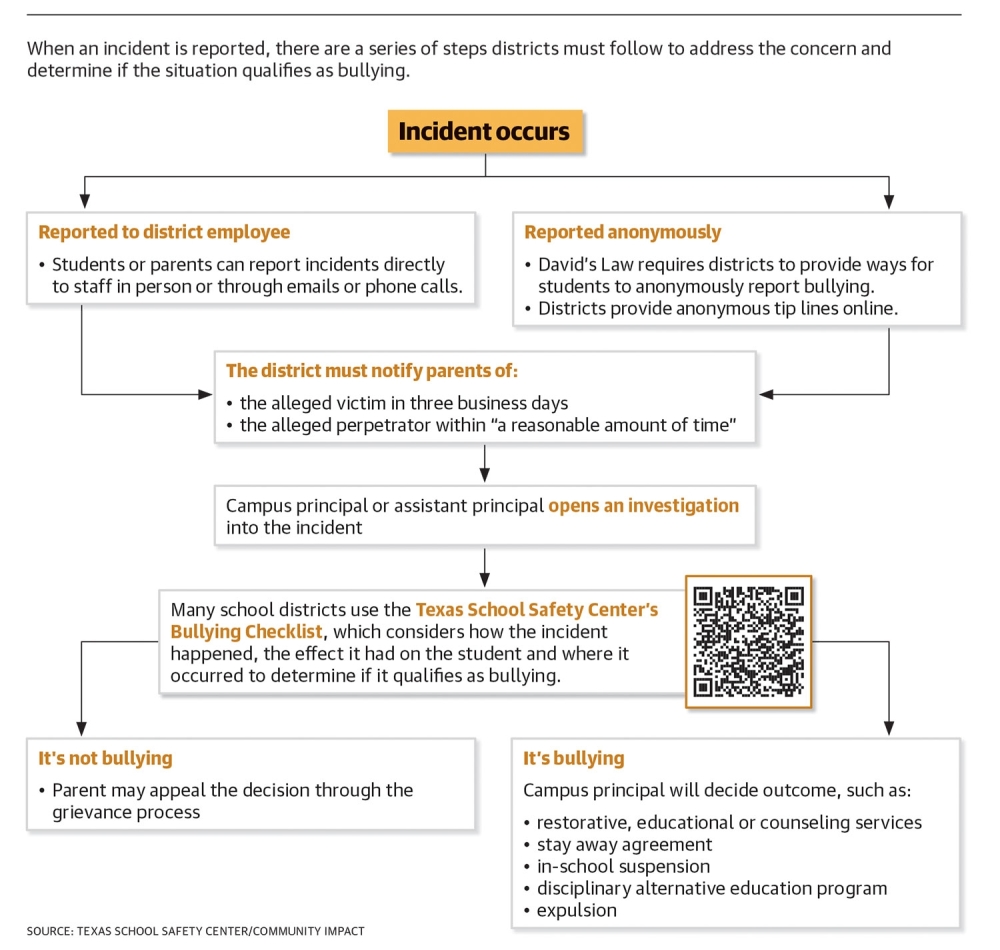The dilemma has brought attention to the state standards school districts must follow in addressing bullying reports and the local processes parents must follow if displeased with a district’s ruling. District officials with LTISD and Eanes ISD have said bullying is a problem they’re actively trying to solve.
“We are trying to address bullying,” said Molly May, assistant superintendent of curriculum, instruction and assessment for EISD. “It is a challenge, and it’s not something that the schools can do alone.”
Two-minute impact
Former LTISD parent Shawna Mannon sued the district for $1.5 million in April on behalf of her son for its “failure to address the ongoing bullying” he experienced because of his peanut allergy, according to the lawsuit. Mannon shared at a Nov. 15 board of trustees meeting that two of her son’s teammates on the Lake Travis High School football team placed peanuts in his athletic locker.
The district’s investigation determined the legal definition of bullying was not met—a ruling that was affirmed by a review from the TEA. Mannon filed a grievance with the district that closed in February, and her son has transferred out of the district to Leander ISD.
LTISD and EISD have adopted similar policies that require campus administrators to investigate any reported incidents of bullying. If parents disagree with the district’s determination, they may challenge it through a multistep grievance process.
“I have seen very few grievance processes that have turned out in favor of the parent. It is not designed to be parent-friendly,” said Maurine Molak, co-founder of David’s Legacy Foundation, an advocate for antibullying legislation and education.
As a national issue, bullying affects individuals across all sexes, sexual identities, races and ethnicities both at school and online, the latter of which districts are still grappling with how to address.
The approach
Parents and students can report bullying directly to district staff or through anonymous forms. After an incident is reported, a campus principal or assistant principal will conduct an investigation to determine if it qualifies as bullying under state law, district officials said.
If an incident meets the legal definition of bullying, the disciplinary response can differ due to the circumstances, campuses or administrators involved in the incident, district officials, antibullying advocates and parents said.
Jennifer Montgomery, a parent in LTISD and president of Lake Travis Voices for Progress, said her two children had contrasting experiences related to bullying at their separate campuses, which she believes is due to different leadership. Teachers intervened promptly when her son experienced bullying, while her daughter’s school failed to take a threat toward her seriously, she said.
“I think it really comes from the top down,” Montgomery said. “If the adults take it seriously, then the kids know it’s going to be taken seriously.”
Molak said it’s common for parents and districts to disagree on what constitutes bullying. Her antibullying organization, founded after her son died by suicide after being cyberbullied, provides legal aid to families and championed the passage of Texas Senate Bill 179, also known as David’s Law.
The law was enacted in 2017 to require districts to respond to cyberbullying that occurs off campus, including contacting law enforcement when necessary.
A rise in cyberbullying has presented new challenges for district officials who must address bullying off school premises. LTISD and EISD officials said it can be difficult to respond to cyberbullying as many perpetrators remain anonymous on social media, and the district isn’t aware of it until students come forward.
“It’s so hard to manage,” May with EISD said.

The outlook
State law provides flexibility on how students are disciplined for bullying as it is determined by a district’s code of conduct, said Kathy Martinez-Prather, director of the Texas School Safety Center.
The disciplinary response to bullying is determined by campus administrators and can vary greatly based on the severity of each situation, officials with each district said. In EISD, a campus administrator may consider a student’s disciplinary history, intent, frequency and other factors, May said.
Districts cannot share with parents how they disciplined another student under federal law, said Jennifer Lyon, LTISD director of health and social emotional learning. Districts may still discipline students if their behavior doesn’t meet the legal definition of bullying but violates the code of conduct, district officials said.
Parents may file a grievance with the district if they wish to challenge the determination or seek additional relief through filing a complaint with the TEA. David’s Law also allows minors or their parents to seek injunctive relief against a cyberbully and their parents, Molak said.
The grievance process
- A community member submits a complaint appealing the district’s determination.
- The district holds a hearing for the request.
- A campus or district administrator reviews the complaint and makes a determination.
- If a parent appeals the decision, the district repeats steps 1-3.
- An administrator makes the final determination upon a second review in EISD. If a parent appeals again in LTISD, the complaint will go to the board of trustees.
The action taken
LTISD has focused on promoting kindness as a more effective way to combat bullying, Lyon said. The district has launched activities at elementary campuses, clubs and committees at secondary campuses, assemblies across the district, and a video series for parents.
This school year, EISD invited Crime Stoppers of Houston to present to students and parents on bullying and cybersafety awareness, May said.
Parents can help protect their children from bullying by having open conversations about mental health and monitoring their social media use, said Shauna Barnes, mental health education manager for the Grant Halliburton Foundation, which provides mental health resources and education.
Signs a child is being bullied can include irritability, changes in sleep or eating habits, and difficulty focusing or completing school work, she said.
David’s law requirements
David’s Law was expanded in 2021, requiring districts to provide more bullying prevention measures, including:
- Providing instruction to students on bullying prevention
- Conducting surveys to measure healthy relationships and positive school culture between students and staff
- Establishing a committee to address bullying through prevention efforts
- Developing a policy for reporting bullying, including anonymous reporting
- Creating a rubric or checklist to assess bullying incidents and determine response
Going forward
LTISD officials plan to use a platform allowing district administrators to better monitor the process of bullying investigations next school year, said Tasha Barker, LTISD assistant superintendent for organizational services.
“That’s the piece that is kind of lacking now ... that we can improve on,” Barker said.
While the number of bullying report forms filed since 2019 were available from LTISD, the district didn’t begin tracking the total number of bullying incidents until this school year, said Stephanie Clinton, public information request specialist. EISD did not respond to requests for bullying data.
To combat online bullying, state House Bill 18 goes into effect in September, providing more online protections for minors, Molak said.





